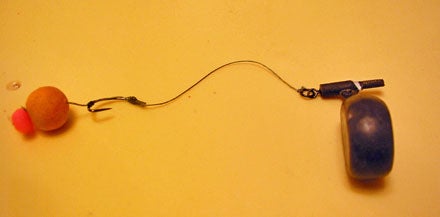Carp RigsI’M GOING TO show a couple of rigs that’ll suit most situations, and the lead arrangements that I use to get them there. All of these have caught fish so it’s one less thing to worry about. Most rigs are a variation on these themes. Braid Blow-Out Rig
Mono Spring Rig
Combi Rig
Pop-Up Rig
Consider the makeup of the bottom, etc When choosing which rig to use you need to consider the makeup of the bottom you are fishing over, the size of fish, and the baiting situation you are using; there is no one rig that’ll suit every situation. I probably use the Combi and Mono rigs the most at around 12″ in length, though I often add a “blow-back” to the combi, and tie the mono rig with a supple hair. They are a good starting point if fishing over a firm bottom, but if fishing over heavy weed/silkweed I would use a short braid rig as I feel it will sit better. Another example would be fishing with big PVA bags over gravel where I feel it better to use a shorter, stiffer hooklength – just have a little think before casting out! I’ve then got four main lead arrangements Clean Bottom Rig Margins/Slopes Of Bars
Distance
Weed
Fixed or running? We refer to rigs as fixed or running – realistically I don’t think that we can have a really freely running rig unless fishing at short range with a clean bottom as the line pulling through weed for instance will add a fair amount drag if you want free running so the fish doesn’t know its been hooked. You also need a heavy lead to stop the lead moving, or again there will be more drag. I like running rigs as I feel the fish can’t use the weight of the lead to shake the hook out. Leadcore You’ll notice that most of the rigs shown are with leadcore. I prefer leadcore when I can use it, normally with as long a length as I can cast, as I feel it hugs the bottom better than tubing. You do need to make sure you can attach the leadcore to the mainline safely, and that all the rig components can easily slide off to prevent fish from becoming snagged. Where I can’t use leadcore, I use ESP’s anchor rig tube as its incredibly heavy – heavier than most leadcores! The weed rig is shown without any tubing or leadcore, I want as little chance of anything snagging the weed, and I don’t think fish are particularly aware of slack lines in weed anyway. Some people worry about mono damaging the fish during the fight, but then we never use tubing when floater fishing do we? Tubing or leadcore to me is just something to disguise the line. NEXT IN PART 4 – How to make your rigs and the line look less visible, and how to set your lines and indicators Points of reference: The Keith Moors Knot – For joining leadcore to the mainline The Rigs Page – For some other rigs, and other views on rigs. |
Welcome!Log into your account




















